Blog & Latest Updates
Fly Fishing Articles
Insects by Common Name


Putting on the miles from West Yellowstone
We began July 1st with plans to fish a lesser-known river that produced well for me last year in the low water of August. Although the scenery was great, we found the river high and off-color due to an unknown combination of snowmelt runoff and rainfall from recent thunderstorms. We still plied the known good water with streamers for an hour or so, but gave up after I had no strikes and my friend missed one.
Wanting to make the most of the drive out there, we drove to try a new spring-fed tributary. Some PMDs and green "yellow sallies" (Chloroperlid stoneflies) were emerging sporadically, but nothing to really get fish rising. However, the water was so clear we could spot the fish anyway -- brook trout on the large side (mostly nine to twelve inches), huddled mostly in small schools in the bottoms of pools. They were skittish and mostly unwilling to rise for dry flies under the bright midday sun, but well-place nymphs brought several fish to hand as we worked our way upstream to the end of the good-looking water.
With much of the day still remaining after that, we drove to the Madison, bought some flies at the Slide Inn, and headed down to the Eight Mile Ford access near Ennis to try our luck. We hoped, on a tip, to find some salmonflies in the area, but there was no sign of them except one solitary shuck (
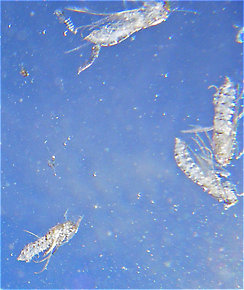
Here's an underwater view of the pupal shucks of several already-emerged Brachycentrus numerosus caddisflies.
Maybe all those caddisflies filled the fish up when they were emerging, or maybe we just didn't have imitation dialed in, but we were unable to catch anything that evening. Nothing was rising, and nothing we did with nymphs, streamers, or soft-hackles drew more than the occasional bump of a maybe-strike. It was hard not to have a good time, however, based on the scenery alone as warm evening light painted the Madison Range and scattered storm clouds added great drama to the view.
Photos by Troutnut from the Madison River, Mystery Creek #237, and Mystery Creek #244 in Montana

StateMontana
LocationMadison River
Date TakenJul 1, 2019
Date AddedJul 17, 2019
AuthorTroutnut
CameraNIKON 1 AW1

StateMontana
LocationMadison River
Date TakenJul 1, 2019
Date AddedJul 17, 2019
AuthorTroutnut
CameraNIKON 1 AW1

StateMontana
LocationMadison River
Date TakenJul 1, 2019
Date AddedJul 17, 2019
AuthorTroutnut
CameraNIKON 1 AW1
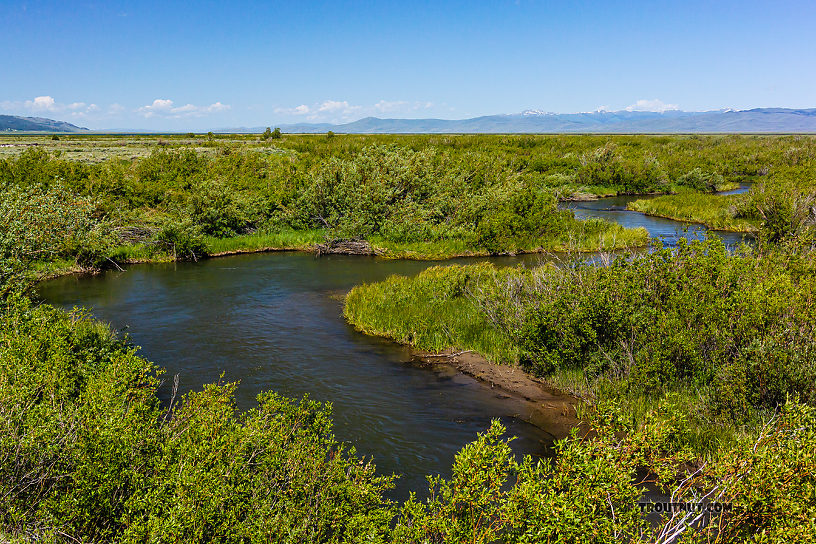




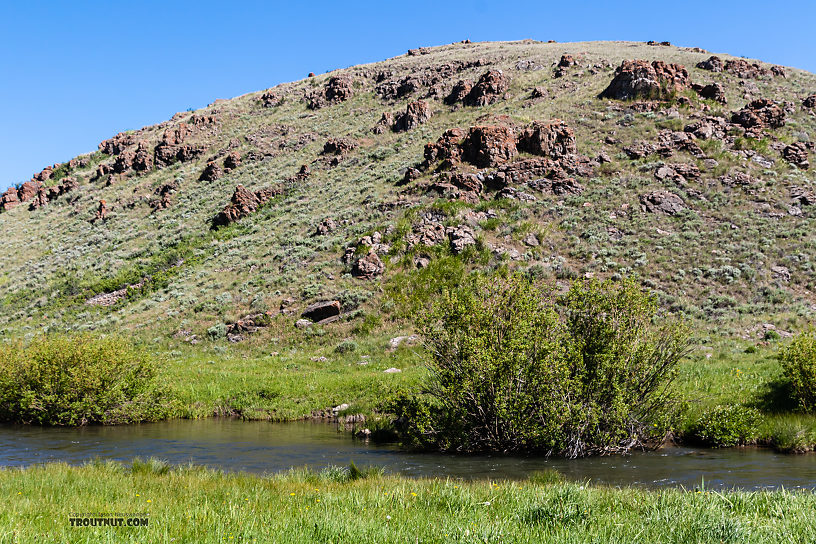
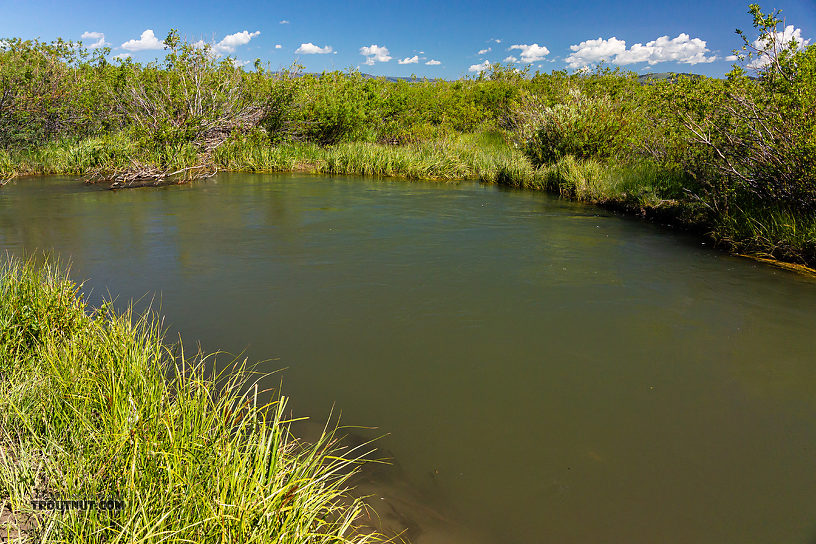



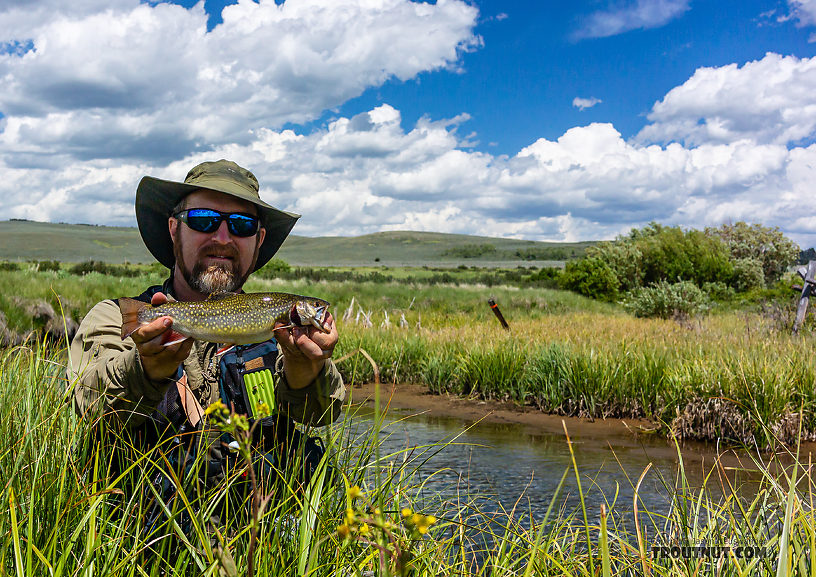
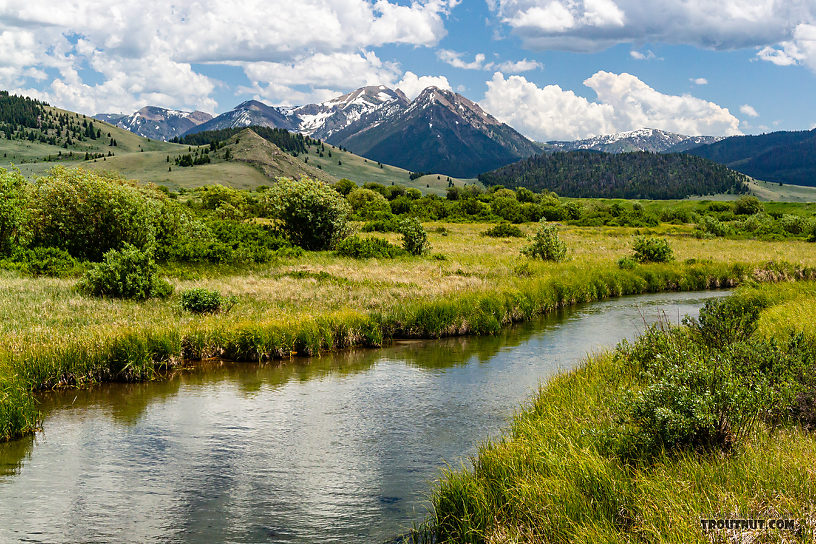
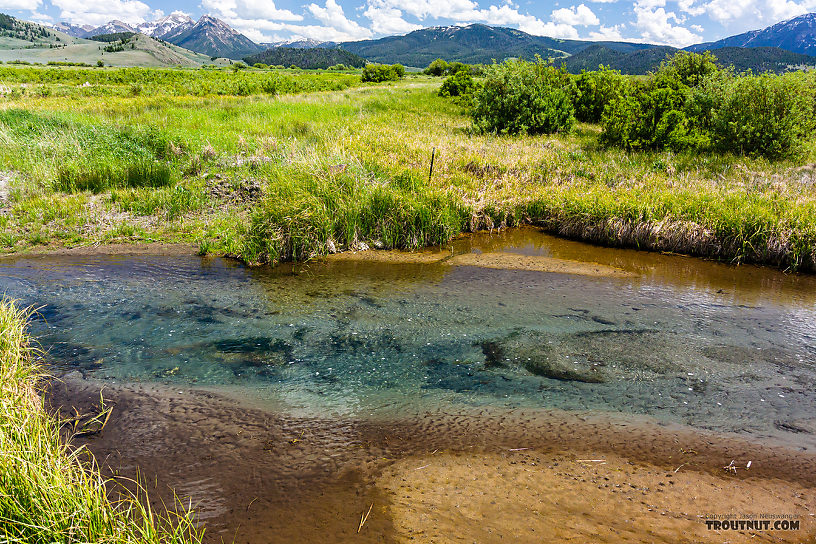
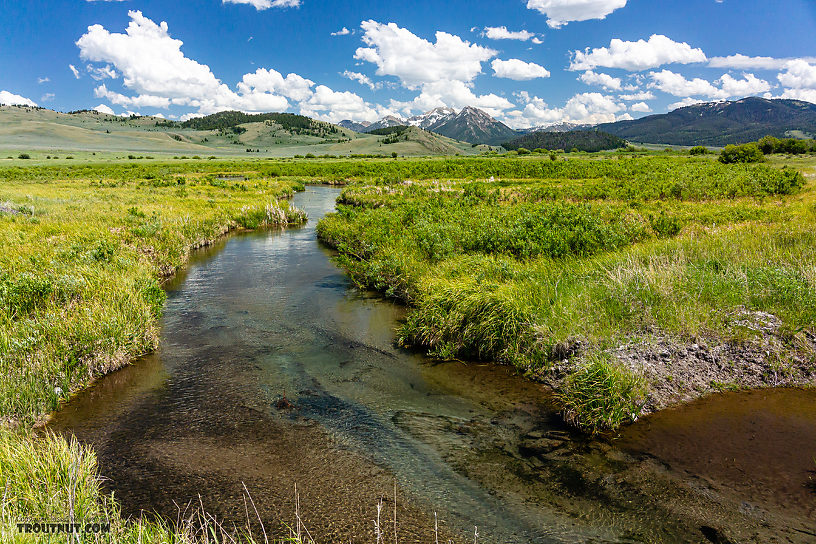
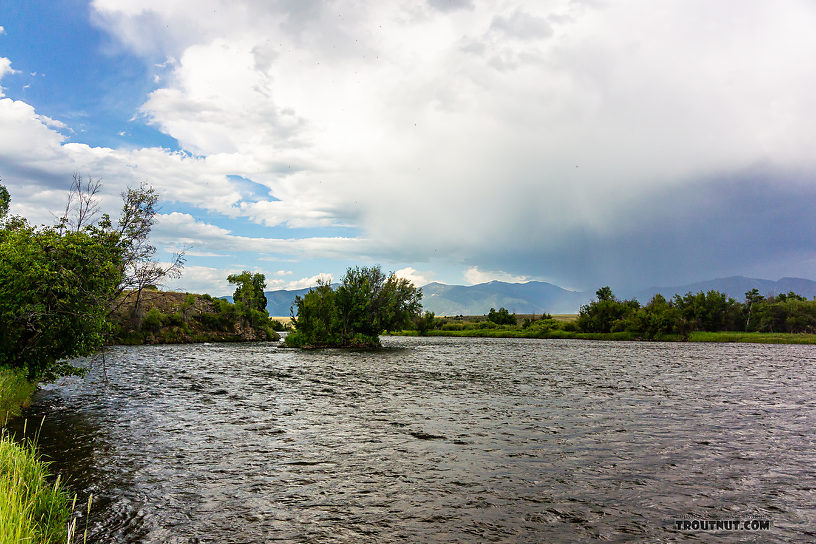
StateMontana
LocationMadison River
Date TakenJul 1, 2019
Date AddedJul 17, 2019
AuthorTroutnut
CameraNIKON 1 AW1

StateMontana
LocationMadison River
Date TakenJul 1, 2019
Date AddedJul 17, 2019
AuthorTroutnut
CameraNIKON 1 AW1
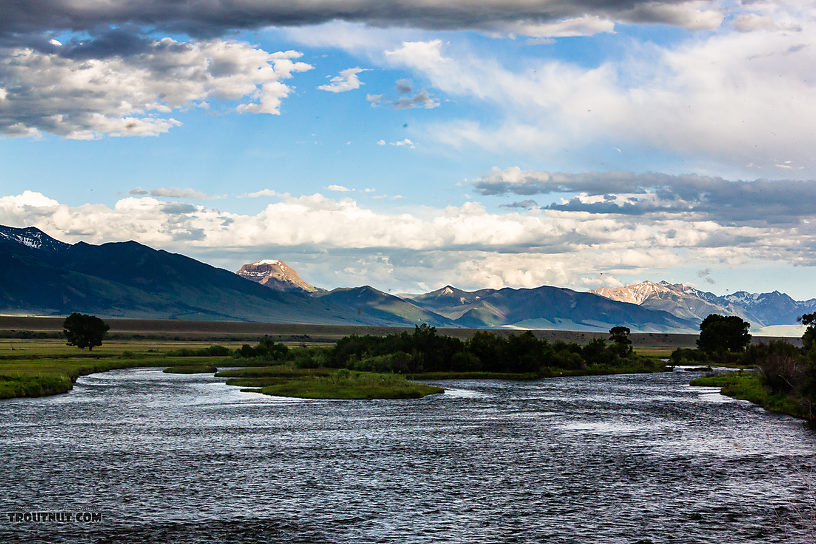
StateMontana
LocationMadison River
Date TakenJul 1, 2019
Date AddedJul 17, 2019
AuthorTroutnut
CameraNIKON 1 AW1
On-stream insect photos by Troutnut from the Madison River in Montana
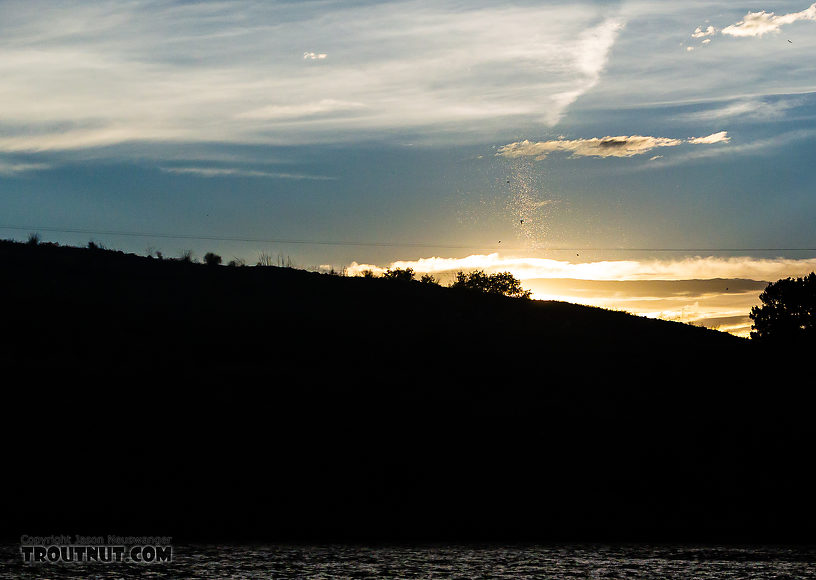
Looking back across the Madison at a cloud of caddisflies swarming over the bank about 50 yards away, backlit by the sun.
StateMontana
LocationMadison River
Date TakenJul 1, 2019
Date AddedJul 17, 2019
AuthorTroutnut
CameraNIKON 1 AW1

We arrived at the parking lot on the Madison to find clouds of caddisflies swarming around everything, including every tree and vehicle in the parking lot.
StateMontana
LocationMadison River
Date TakenJul 1, 2019
Date AddedJul 17, 2019
AuthorTroutnut
CameraNIKON 1 AW1
Closeup insects by Troutnut from the Madison River in Montana
Male Rhithrogena undulata (Small Western Red Quill) Mayfly Spinner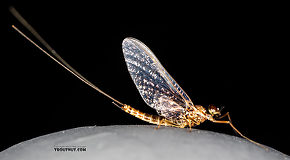 View 13 PicturesThis male was collected at the same time as this female and is likely the same species.
View 13 PicturesThis male was collected at the same time as this female and is likely the same species.
It keys pretty clearly to Rhithrogena undulata using the key in Traver 1935, although the size is larger than expected for that species in that source.
 View 13 PicturesThis male was collected at the same time as this female and is likely the same species.
View 13 PicturesThis male was collected at the same time as this female and is likely the same species.It keys pretty clearly to Rhithrogena undulata using the key in Traver 1935, although the size is larger than expected for that species in that source.
Collected July 1, 2019 from the Madison River in Montana
Added to Troutnut.com by Troutnut on July 18, 2019
Added to Troutnut.com by Troutnut on July 18, 2019
Male Ephemerella aurivillii Mayfly Dun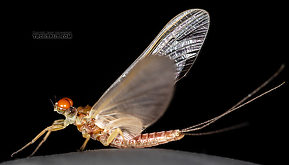 View 7 PicturesThis dun was collected in proximity to this spinner, and to this female that looks like the same species.
View 7 PicturesThis dun was collected in proximity to this spinner, and to this female that looks like the same species.
Among western species, it most closely resembles Ephemerella aurivillii, of which I reared a specimen from a positively-identified nymph and photographed the male dun previously in Alaska. In the photos, this dun does not seem to have the same evidence of the nymph's dorsal (Dorsal: Top.) stripe, but that's due to the lighting. A faint stripe is apparent under the microscope, as it is in the female linked above.
They do appear to be a bit short for aurivillii, with the male at 8 mm and the female at 9 mm, but the spinners could be a bit longer.
Among the other Ephemerella mayflies documented in Montana, Ephemerella alleni and Ephemerella mucronata are the only two others that seem to not be ruled out.
 View 7 PicturesThis dun was collected in proximity to this spinner, and to this female that looks like the same species.
View 7 PicturesThis dun was collected in proximity to this spinner, and to this female that looks like the same species.Among western species, it most closely resembles Ephemerella aurivillii, of which I reared a specimen from a positively-identified nymph and photographed the male dun previously in Alaska. In the photos, this dun does not seem to have the same evidence of the nymph's dorsal (Dorsal: Top.) stripe, but that's due to the lighting. A faint stripe is apparent under the microscope, as it is in the female linked above.
They do appear to be a bit short for aurivillii, with the male at 8 mm and the female at 9 mm, but the spinners could be a bit longer.
Among the other Ephemerella mayflies documented in Montana, Ephemerella alleni and Ephemerella mucronata are the only two others that seem to not be ruled out.
Collected July 1, 2019 from the Madison River in Montana
Added to Troutnut.com by Troutnut on July 18, 2019
Added to Troutnut.com by Troutnut on July 18, 2019
Male Ephemerella dorothea infrequens (Pale Morning Dun) Mayfly Spinner View 6 PicturesThis spinner was collected in proximity to this dun and this other dun, so one of them is likely the same species. Note for ID purposes that this one is missing one of its cerci (Cercus: The left and right "tails" of an insect are known as the cerci or caudal cerci. The middle tail of a three-tailed insect is not.).
View 6 PicturesThis spinner was collected in proximity to this dun and this other dun, so one of them is likely the same species. Note for ID purposes that this one is missing one of its cerci (Cercus: The left and right "tails" of an insect are known as the cerci or caudal cerci. The middle tail of a three-tailed insect is not.).
 View 6 PicturesThis spinner was collected in proximity to this dun and this other dun, so one of them is likely the same species. Note for ID purposes that this one is missing one of its cerci (Cercus: The left and right "tails" of an insect are known as the cerci or caudal cerci. The middle tail of a three-tailed insect is not.).
View 6 PicturesThis spinner was collected in proximity to this dun and this other dun, so one of them is likely the same species. Note for ID purposes that this one is missing one of its cerci (Cercus: The left and right "tails" of an insect are known as the cerci or caudal cerci. The middle tail of a three-tailed insect is not.).Collected July 1, 2019 from the Madison River in Montana
Added to Troutnut.com by Troutnut on July 18, 2019
Added to Troutnut.com by Troutnut on July 18, 2019
Male Neoleptophlebia heteronea (Blue Quill) Mayfly Spinner View 12 PicturesI keyed this one out to species on the microscope because it was too small for the genitalia to show the distinguishing characteristics in the images here.
View 12 PicturesI keyed this one out to species on the microscope because it was too small for the genitalia to show the distinguishing characteristics in the images here.
 View 12 PicturesI keyed this one out to species on the microscope because it was too small for the genitalia to show the distinguishing characteristics in the images here.
View 12 PicturesI keyed this one out to species on the microscope because it was too small for the genitalia to show the distinguishing characteristics in the images here.Collected July 1, 2019 from the Madison River in Montana
Added to Troutnut.com by Troutnut on July 18, 2019
Added to Troutnut.com by Troutnut on July 18, 2019
Male Malenka tina (Tiny Winter Black) Stonefly Adult View 7 PicturesThis is the smallest stonefly I've ever collected, with a body only 5.5 mm long.
View 7 PicturesThis is the smallest stonefly I've ever collected, with a body only 5.5 mm long.
Although not in-focus in my pictures, its first tarsal segment is similar in length to the third, while the second is much shorter. This helps with family-level identification.
Examining this specimen under a microscope shows a membranous lobe on the dorsal (Dorsal: Top.) base of the cerci (Cercus: The left and right "tails" of an insect are known as the cerci or caudal cerci. The middle tail of a three-tailed insect is not.), which is the key characteristic in Merritt & Cummins (4th ed.) to place the genus definitively as Malenka.
Following the species key in Jewett Jr's Stoneflies of the Pacific Northwest, the species appears to be Malenka tina. My dissecting microscope seems to show sternite (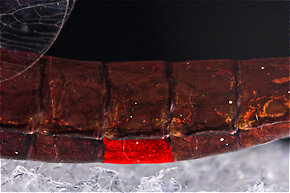 Sternite: The bottom (ventral) part of a single segment on an insect's abdomen.) 9 ending in a rounded knob, which distinguishes it from Malenka bifurcata, but the detail is hard to work out.
Sternite: The bottom (ventral) part of a single segment on an insect's abdomen.) 9 ending in a rounded knob, which distinguishes it from Malenka bifurcata, but the detail is hard to work out.
Also worth noting is that Montana appears to have this species, whereas birfucata is not know there: http://fieldguide.mt.gov/displaySpecies.aspx?family=Nemouridae
 View 7 PicturesThis is the smallest stonefly I've ever collected, with a body only 5.5 mm long.
View 7 PicturesThis is the smallest stonefly I've ever collected, with a body only 5.5 mm long.Although not in-focus in my pictures, its first tarsal segment is similar in length to the third, while the second is much shorter. This helps with family-level identification.
Examining this specimen under a microscope shows a membranous lobe on the dorsal (Dorsal: Top.) base of the cerci (Cercus: The left and right "tails" of an insect are known as the cerci or caudal cerci. The middle tail of a three-tailed insect is not.), which is the key characteristic in Merritt & Cummins (4th ed.) to place the genus definitively as Malenka.
Following the species key in Jewett Jr's Stoneflies of the Pacific Northwest, the species appears to be Malenka tina. My dissecting microscope seems to show sternite (

One sternite of this Isonychia bicolor mayfly spinner is highlighted in red.
Also worth noting is that Montana appears to have this species, whereas birfucata is not know there: http://fieldguide.mt.gov/displaySpecies.aspx?family=Nemouridae
Collected July 1, 2019 from the Madison River in Montana
Added to Troutnut.com by Troutnut on July 18, 2019
Added to Troutnut.com by Troutnut on July 18, 2019
Male Ephemerella dorothea infrequens (Pale Morning Dun) Mayfly Spinner View 10 Pictures
View 10 Pictures
 View 10 Pictures
View 10 PicturesCollected July 1, 2019 from the Madison River in Montana
Added to Troutnut.com by Troutnut on July 18, 2019
Added to Troutnut.com by Troutnut on July 18, 2019
Male Cheumatopsyche (Little Sister Sedges) Caddisfly Adult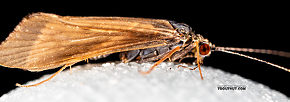 View 12 PicturesI didn't identify this one directly, but I eventually identified one of several I collected from the same swarms that appeared to be of the same species. (I lost track of which specimen was which in storage.) The microscope pictures come from one of these specimen, not necessarily the same specimen as the DSLR pictures. They key to Cheumatopsyche, and the hind wing venation (Venation: The pattern in which the veins on the wings of an insect are arranged. It is usually one of the most useful identifying characteristics.) that separates them from Hydropsyche is pretty clear in the attached picture as well as another specimen I checked under the scope.
View 12 PicturesI didn't identify this one directly, but I eventually identified one of several I collected from the same swarms that appeared to be of the same species. (I lost track of which specimen was which in storage.) The microscope pictures come from one of these specimen, not necessarily the same specimen as the DSLR pictures. They key to Cheumatopsyche, and the hind wing venation (Venation: The pattern in which the veins on the wings of an insect are arranged. It is usually one of the most useful identifying characteristics.) that separates them from Hydropsyche is pretty clear in the attached picture as well as another specimen I checked under the scope.
This specimen was one of tens of thousands we saw on a July 1st evening on the Madison, beginning with big swarms around every vehicle and tree at the Eight Mile Ford access point and continuing all up and down the river bank. We somehow didn't catch any trout, perhaps because they were stuffed with pupae from when these things emerged. Or maybe we just weren't fishing well. Either way, this one represents a major hatch there.
I somehow forgot to photograph this important specimen against the hooks size chart, but fortunately I preserved a few. The body length is about 6 mm, and total length from head to wingtip is 9 mm.
 View 12 PicturesI didn't identify this one directly, but I eventually identified one of several I collected from the same swarms that appeared to be of the same species. (I lost track of which specimen was which in storage.) The microscope pictures come from one of these specimen, not necessarily the same specimen as the DSLR pictures. They key to Cheumatopsyche, and the hind wing venation (Venation: The pattern in which the veins on the wings of an insect are arranged. It is usually one of the most useful identifying characteristics.) that separates them from Hydropsyche is pretty clear in the attached picture as well as another specimen I checked under the scope.
View 12 PicturesI didn't identify this one directly, but I eventually identified one of several I collected from the same swarms that appeared to be of the same species. (I lost track of which specimen was which in storage.) The microscope pictures come from one of these specimen, not necessarily the same specimen as the DSLR pictures. They key to Cheumatopsyche, and the hind wing venation (Venation: The pattern in which the veins on the wings of an insect are arranged. It is usually one of the most useful identifying characteristics.) that separates them from Hydropsyche is pretty clear in the attached picture as well as another specimen I checked under the scope. This specimen was one of tens of thousands we saw on a July 1st evening on the Madison, beginning with big swarms around every vehicle and tree at the Eight Mile Ford access point and continuing all up and down the river bank. We somehow didn't catch any trout, perhaps because they were stuffed with pupae from when these things emerged. Or maybe we just weren't fishing well. Either way, this one represents a major hatch there.
I somehow forgot to photograph this important specimen against the hooks size chart, but fortunately I preserved a few. The body length is about 6 mm, and total length from head to wingtip is 9 mm.
Collected July 1, 2019 from the Madison River in Montana
Added to Troutnut.com by Troutnut on July 18, 2019
Added to Troutnut.com by Troutnut on July 18, 2019
Male Lepidostoma (Little Brown Sedges) Little Brown Sedge Adult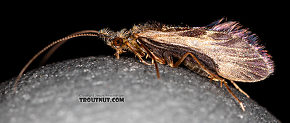 View 7 PicturesOn an evening filled with millions of caddisflies, this one stood out as the only one of its kind that found its way into my net. Dave Ruiter identified it from the photos as a Lepidostoma specimen in the pluviale species group.
View 7 PicturesOn an evening filled with millions of caddisflies, this one stood out as the only one of its kind that found its way into my net. Dave Ruiter identified it from the photos as a Lepidostoma specimen in the pluviale species group.
 View 7 PicturesOn an evening filled with millions of caddisflies, this one stood out as the only one of its kind that found its way into my net. Dave Ruiter identified it from the photos as a Lepidostoma specimen in the pluviale species group.
View 7 PicturesOn an evening filled with millions of caddisflies, this one stood out as the only one of its kind that found its way into my net. Dave Ruiter identified it from the photos as a Lepidostoma specimen in the pluviale species group.Collected July 1, 2019 from the Madison River in Montana
Added to Troutnut.com by Troutnut on July 18, 2019
Added to Troutnut.com by Troutnut on July 18, 2019
Male Ephemerella dorothea infrequens (Pale Morning Dun) Mayfly Dun View 7 PicturesThis dun was collected in proximity to this spinner.
View 7 PicturesThis dun was collected in proximity to this spinner.
 View 7 PicturesThis dun was collected in proximity to this spinner.
View 7 PicturesThis dun was collected in proximity to this spinner.Collected July 1, 2019 from the Madison River in Montana
Added to Troutnut.com by Troutnut on July 18, 2019
Added to Troutnut.com by Troutnut on July 18, 2019
Female Ephemerella aurivillii Mayfly Dun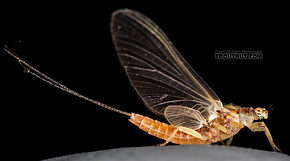 View 6 PicturesThis female was collected in proximity to a male that looks like the same species.
View 6 PicturesThis female was collected in proximity to a male that looks like the same species.
 View 6 PicturesThis female was collected in proximity to a male that looks like the same species.
View 6 PicturesThis female was collected in proximity to a male that looks like the same species.Collected July 1, 2019 from the Madison River in Montana
Added to Troutnut.com by Troutnut on July 18, 2019
Added to Troutnut.com by Troutnut on July 18, 2019
Female Rhithrogena undulata (Small Western Red Quill) Mayfly Spinner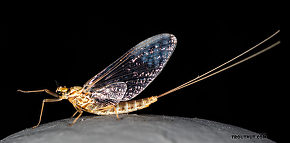 View 5 PicturesThis one was collected at the same time as this male and is likely the same species.
View 5 PicturesThis one was collected at the same time as this male and is likely the same species.
 View 5 PicturesThis one was collected at the same time as this male and is likely the same species.
View 5 PicturesThis one was collected at the same time as this male and is likely the same species.Collected July 1, 2019 from the Madison River in Montana
Added to Troutnut.com by Troutnut on July 17, 2019
Added to Troutnut.com by Troutnut on July 17, 2019
Female Ephemerella dorothea infrequens (Pale Morning Dun) Mayfly Spinner View 9 PicturesI'm calling this one Ephemerella dorothea infrequens because it was collected along with two males that positively ID to that species.
View 9 PicturesI'm calling this one Ephemerella dorothea infrequens because it was collected along with two males that positively ID to that species.
 View 9 PicturesI'm calling this one Ephemerella dorothea infrequens because it was collected along with two males that positively ID to that species.
View 9 PicturesI'm calling this one Ephemerella dorothea infrequens because it was collected along with two males that positively ID to that species.Collected July 1, 2019 from the Madison River in Montana
Added to Troutnut.com by Troutnut on July 18, 2019
Added to Troutnut.com by Troutnut on July 18, 2019
Most recent comments on this post (latest on top)
Comment on this post
Top 10 Fly Hatches
Top Gift Shop Designs
Eat mayflies.
Top Insect Specimens
Miscellaneous Sites
Troutnut.com is copyright © 2004-2024 Jason
Neuswanger (email Jason). See my FAQ for information about use of my images.
 privacy policy
privacy policy
